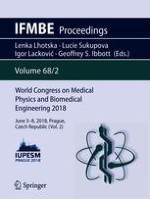2019 | OriginalPaper | Buchkapitel
Pulse Rate Variability Analysis to Enhance Oximetry as at-Home Alternative for Sleep Apnea Diagnosing
verfasst von : Gonzalo C. Gutiérrez-Tobal, Daniel Álvarez, Fernando Vaquerizo-Villar, Verónica Barroso-García, Adrián Martín-Montero, Andrea Crespo, Félix del Campo, Roberto Hornero
Erschienen in: World Congress on Medical Physics and Biomedical Engineering 2018
Verlag: Springer Singapore
Aktivieren Sie unsere intelligente Suche, um passende Fachinhalte oder Patente zu finden.
Wählen Sie Textabschnitte aus um mit Künstlicher Intelligenz passenden Patente zu finden. powered by
Markieren Sie Textabschnitte, um KI-gestützt weitere passende Inhalte zu finden. powered by
